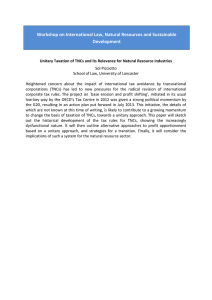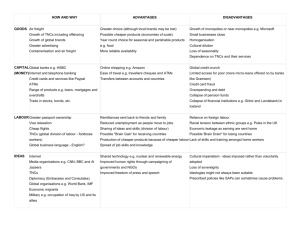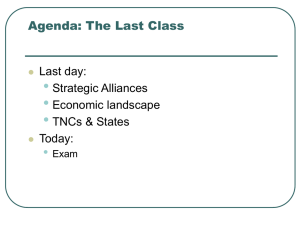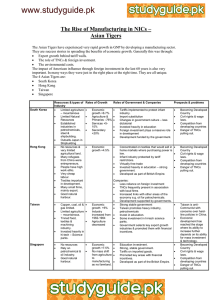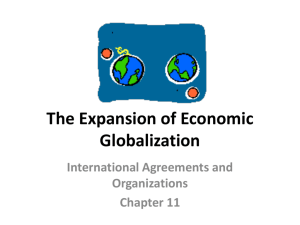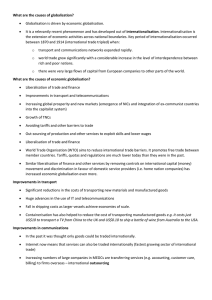Economic collaboration Olav
advertisement
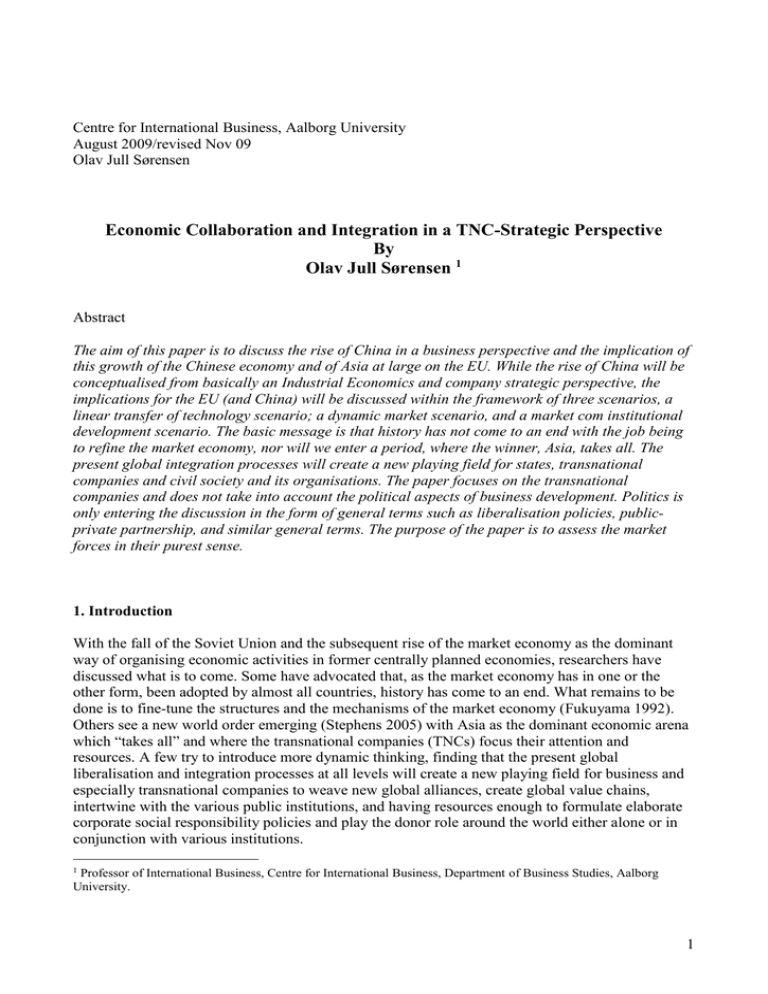
Centre for International Business, Aalborg University August 2009/revised Nov 09 Olav Jull Sørensen Economic Collaboration and Integration in a TNC-Strategic Perspective By Olav Jull Sørensen 1 Abstract The aim of this paper is to discuss the rise of China in a business perspective and the implication of this growth of the Chinese economy and of Asia at large on the EU. While the rise of China will be conceptualised from basically an Industrial Economics and company strategic perspective, the implications for the EU (and China) will be discussed within the framework of three scenarios, a linear transfer of technology scenario; a dynamic market scenario, and a market com institutional development scenario. The basic message is that history has not come to an end with the job being to refine the market economy, nor will we enter a period, where the winner, Asia, takes all. The present global integration processes will create a new playing field for states, transnational companies and civil society and its organisations. The paper focuses on the transnational companies and does not take into account the political aspects of business development. Politics is only entering the discussion in the form of general terms such as liberalisation policies, publicprivate partnership, and similar general terms. The purpose of the paper is to assess the market forces in their purest sense. 1. Introduction With the fall of the Soviet Union and the subsequent rise of the market economy as the dominant way of organising economic activities in former centrally planned economies, researchers have discussed what is to come. Some have advocated that, as the market economy has in one or the other form, been adopted by almost all countries, history has come to an end. What remains to be done is to fine-tune the structures and the mechanisms of the market economy (Fukuyama 1992). Others see a new world order emerging (Stephens 2005) with Asia as the dominant economic arena which “takes all” and where the transnational companies (TNCs) focus their attention and resources. A few try to introduce more dynamic thinking, finding that the present global liberalisation and integration processes at all levels will create a new playing field for business and especially transnational companies to weave new global alliances, create global value chains, intertwine with the various public institutions, and having resources enough to formulate elaborate corporate social responsibility policies and play the donor role around the world either alone or in conjunction with various institutions. 1 Professor of International Business, Centre for International Business, Department of Business Studies, Aalborg University. 1 The aim of this paper is in a modest way to contribute to these reflections on the globalised future. More specifically, the aim is to discuss the rise of China in a business perspective and the implication of this growth of the Chinese economy and of Asia at large on the EU. While the rise of China will be conceptualised from basically an Industrial Economics and company strategic perspective, the implications for the EU (and China) will be discussed within the framework of three scenarios, a linear transfer of technology scenario; a dynamic market scenario, and a market com institutional development scenario. In all three scenarios, the business strategy perspective of TNCs will play an essential role as it is assumed (and believed) that the strategic interests and actual market behaviour of the TNCs will drive the global economy. This is even more so if the liberal trade and investment regime, as assumed, continues to be the accepted mode of organising economic activity. Different versions of the market economy may appear, but the core values and mechanisms of the market economy are intact and there will, it is assumed, be a global economic playing field. 2. Business Perspective: What does it imply? Over the last 25 years, country by country has opted for a liberal trade and investment regime and thus created a large open playing field for the development of transnational companies. When the world consisted of many more or less closed and protected markets and a central plan to direct development, TNCs, in the main, used two strategies to mount the barriers: They pursued a multidomestic FDI strategy (Porter 1980), i.e., they developed a strategy for each an every country to comply with the specificities of that country (Whitley 1994) and entering an agreement with the Government in question. The other strategy was basically an exporting strategy as the TNCs exported products, but more important, they exported complete production entities to comply with the dominant import substitution policies of most developing countries and centrally planned economies. The terms “system’s export” and “turn key project” were coined for this way of overcoming the barriers of a entering a country. This way the centralized economies hoped to buy modern technology. When realising that acquiring the technology was not enough, they, at times, entered management contracts with TNCs to run the new factories. With the liberalisation wave and the associated export strategy, which in many cases was part of the way to achieve economic growth, TNCs got an almost global playing field on which they could move resources and competencies and thus take advantage of pockets of comparative advantages, competitive advantages, and changes in demand. The portfolio of strategies used by TNCs are, in this case, more complex compared to the central planning era. We can identify four main strategies, which at times are combined and interlinked: 1. Searching for markets (income generation) 2. Searching for efficiency (cost reduction) 3. Searching for innovation (value creation). 4. Searching for synergy through global coordination and transfer of knowledge (synergy leveraging) In a value chain perspective (Sorensen 2009), the TNCs aim to exploit their existing competitive advantages downstream by identifying markets. They are at the same time trying to explore new 2 competitive advantages upstream in two ways: First, by relocating production to areas with lower costs of production, notably labour costs (as this production factor is less mobile and thus must be utilized where it is located). This has been done through an outsourcing strategy or a foreign direct investment (FDI) strategy. Secondly, they have accessed new knowledge and even globalised their R&D activities, to innovate and thus add new value to their market offers. Finally, when TNCs have expanded their various activities internationally, they adopt strategies that will integrate and coordinate the globally distributed activities and thus capture possible synergies between them. The market searching strategy and thus the exploitation of existing competitive advantages can be found in the old economies as well as in the new growth economies. However, the strategy for exploring new competitive advantages was, in the beginning, relatively simple: If you wanted to lower costs, look and move east. If you want to innovate, look and move west. This picture has been more blurred as some countries, notably China, are able to attract TNCs and encompass all four strategies at the same time. This is why China is so attractive. These four strategies are implemented by using basically three operational modes as shown in Figure 1, i.e. a trading mode (export/import), a foreign direct investment mode (subsidiaries, joint ventures and mergers and acquisitions), and a strategic alliance mode with its normally long-term, trustful relations between the partners in case of sub-contracting and outsourcing. As Figure 1. TNCs’ Global Operational Modes Exports Trade Sourcing Strategic alliances Subsidiary Foreign Direct Investment Joint Venture M&A Leaving the individual TNC-strategic perspective and looking at the meso-level, we can observe two important consequences of the liberalisation and export policies of the emerging economies. The first is that coordination of activities at the vertical level is increasingly taking place driven by TNCs. This has formed so-called global value chains that compete against each other and thus making it crucial that every link in the global value chain (GVC) is working efficient and innovative. Secondly, the number of TNCs in any given country has increased tremendously and in emerging market economies, TNCs have formed a TNC-market that to a large extent drives the economy, and force local companies to upgrade (Sorensen and Kuada 2006; Hansen and Schaumburg-Müller 2006). 3 Thus, what we can observe is that under the liberalised trading and investment regime, TNCs weave across countries a network of subsidiaries(sales, production, R&D, etc.), which together with partners form coordinated global value chains. Depending on the mobility of resources, the TNCs will be able to exploit comparative advantages across nations, both natural ones and others created by the policies and plans of each country. 3. The Rise of Economic China/Asia In an international business perspective, it seems that five factors, have contributed to the rise of economic China. These factors are: 2 The adoption of a (relatively) liberal trade and investment regime adhering to the WTO framework. The comparative advantage especially related to labour costs The advantage of having resourceful ethnic Chinese in other countries in the region (HK, Singapore, Taiwan, Malaysia, etc) and in the EU and USA. The rise in household income triggering an increase in domestic demand The establishment of a TNC-driven market based on the sheer number of TNCs The two former factors are the classical ones that have been at work since the 1980’ies and especially throughout the 1990’ies exploited by TNCs on their continuous search for competitive advantages through cost efficiency to satisfy an increasing demand in their home countries. In a dynamic perspective, three factors may bring an end to these classical drivers of the Chinese growth. First, the TNCs may exhaust there possibilities and not have more activities to outsource. The outsourcing strategy runs out of steam. Second, the demand, as in the present economic crisis, in the West may dwindle and third, costs of production in China will increase as labour becomes more scarce, quantitatively but even more so in qualitative terms when highly skilled labour with both high educational background and industrial experience become scarce. Thus, TNCs start insourcing again or at least locate production closer to their main markets in Europe and the US. However, it does not mean that they will stop producing in Asia. As the market in Asia grows, they may in fact expand the production to serve the local markets. The third factor, the ethnic Chinese living in diasporas, has and still have the financial resources to invest in China and the liability of foreignness (Luo and Mezias, 2002) is low due to the common cultural background and the common way of thinking about and conducting of business. (Dicken 2007). The very same Chinese businessmen abroad are also the bridge for Chinese companies to enter foreign markets. The fourth factor is perhaps the most important factor in the medium term. Although Chinese are not big spenders (Horioka and Wan 2006) and prefer to save the money, the growth rates over the last 20 years, have created a huge and also very differentiated domestic market. This has given rise to three trends: First, foreign TNCs have adopted a dual strategy by complementing their existing outsourcing strategy with that of a market seeking one to penetrate the Chinese market. Some 2 Other factors have also been important, e.g. private property policies, commercialisation/privatisation of state companies, weak controls, etc. 4 companies have even appointed China as their 2nd home market and restructured their organisation accordingly by having two centres, the old HQ and an emerging one in China. Perhaps we are seeing the first sign of TNCs with a triad strategy of having three collaborate but still autonomous centres. More important is, however, that the domestic increase in demand has created a base for Chinese entrepreneurs and companies. They can now develop and market products suitable for the Chinese customers both in terms of buying power and in terms of taste. They hit a market that TNCs cannot easily reach – the low income market. This market is constituted by the majority of Chinese, most of which have some annual increase in buying power and they are looking for reliable but cheap products. Learning from TNCs, the Chinese companies have started developing their own brands and in a dynamic and global perspective, some of them will be newcomers – at the same time as they are also latecomers – to the global market arena. In case of the fifth factor, the adoption of the liberal trading and investment regimes provided the framework for TNCs to establish abroad. When countries restricted 100% ownership, JVs were formed, but when the governments allowed 100% ownership, TNCs increasingly turned their JVs into subsidiaries (See analysis from Vietnam in Nhuong et al, 2009). According to UNCTADStatistics, there were around 70.000 TNCs with around 850.000 subsidiaries in 2004. In China, there are more than 300.000 subsidiaries. The subsidiaries are in many different industries and established for various reasons (outsourcing, market, serving clients that have moved to China, etc). The aim is not to discuss the various motives, but to focus on the fact that the TNCs themselves forms a market consisting of advanced buyers and producers. Apart from the TNC-market, the TNCs cater for the upper Chinese market. TNCs normally speak of an A, B, and C market in China, where the TNC cater for the A-market that comprises the TNC-market and the upper Chinese market, while the B-market is served by Chinese companies. In a dynamic perspective, the TNCs try to develop products so that they can take a share of the often big B-market, while the Chinese companies learn on the B-market and increasingly will be able to challenge the TNCs on the Amarket. While competition expectedly will be stiff due to increase in the production capacity compared to increase in demand, we will most likely see mergers and acquisitions between TNCs and Chinese companies. However, the main point in understanding the rise of economic China is that a TNC-market is created and this market drives to a large extent the economy and give rise to spill-overs from TNCs to Chinese companies. Thus, looking across these five factors, we may label the first period of the rise of economic China, the outsourcing period, the second phase for the domestic market expansion both by local companies and TNCs, and the third phase will be the export and outward FDI phase where Chinese – as latecomers – start their internationalisation journey trying to overcome the liability of foreigness on the home market of the TNCs. 4. The Impact on the EU To capture the implications of the rise of economic China, and East Asia in general, for the EU, it is appropriate to work with various scenarios as we need to speculate on what the future may bring. We will work with three scenarios, the first being the linear transfer of resources scenario; the second the dynamic market development scenario and the third the dynamic market-com global institutional development scenario. From our speculations we have omitted any melt down of the global economy scenario, but we have, in the three scenarios, included a need for sustainable economic activities, the need for catering for the welfare of poor people (two third of world 5 population), the need for alternative energy resources coupled to the global warming threat. These global issues are not treated separately, but in general as a platform for economic activity. Scenario 1: The linear transfer of resources scenario The first scenario assumes that China increases and consolidates its present role as the manufacturing powerhouse of the global economy. The TNC-led outsourcing phase, taking advantage of the Chinese comparative advantage on labour costs and the open borders, created the foundation for the emerging manufacturing power house position. The development of the domestic market will follow up and become the engine of the power house. TNCs will, as mentioned, try to get their share of the growing demand by moving resources to China in three ways: If TNCs already have outsourcing activities within own subsidiaries, they will use this platform to penetrate the Chinese market. If TNCs operate in China through JVs, they will do the same or establish own production and sales facilities; Finally, TNCs that did not outsource activities will establish exports to China. Due to the early outsourcing phase, the internationalisation pattern has changed somewhat compared to what was seen previously. However, the outsourcing phase has been beneficial to the TNCs as they have gained detailed knowledge about and networks within the Chinese market that can be used when they start penetrating the market. However, TNCs have not stopped at exporting to and production in China. They have increasingly established R&D-activities for various reasons (Sørensen 2009), two of the more important reasons being the need to adapt market offers to the local market and the access to talent by way of engineers and scientists that are in short supply in the EU and the USA. Thus, TNCs are within the scenario 1 perspective transferring even valuable or core resources ( Prahalad) to their operations in China. This process will within the rationale of scenario 1 have a downawrd spiralling effects in the EU. Outsourcing means that jobs are lost in the EU. Furthermore, the EU also looses production knowhow as experiential knowledge from production activities and the close interaction between production and R&D, will disappear. The labour unions in the EU have protested, but were met with the argument that we have to adjust to the dynamics of the world and that we, i.e. the EU, was still sitting on the most valuable resource, the R&D, the design and the marketing expertise and the associated knowledge and capabilities to develop knowledge. With the increase in the transfer of R&D capacity and capabilities to China, this argument becomes less convincing. The result of scenario 1 is that the EU will loose jobs, loose knowhow and the TNCs will focus their attention and resources elsewhere as they are able to move the resources. Nations cannot move. Thus, scenario 1 leads to a prosperous China and a struggling EU, because business will focus their attention and move their resources to China. The TNCs will still have valuable resources in the EU to underpin the Asian adventures, but the markets are not growing. Scenario 2: The dynamic market development scenario. The 2nd scenario assumes that the global dynamic processes will create a new world order of “international TNCs among others”, i.e. a situation where the competitive platform is more global 6 and the interconnectivity among TNCs and countries is intensive. In this scenario, it is also assumed that any growth pattern in a country will tend to produce its own contradictions that will hamper or bring to an end the present development. The starting point in Scenario 2 is that Chinese companies have developed into to-become-TNCs through the experiences gained on the home-market. However, on the global market, they are latecomers and thus need to penetrate existing business networks in the developed market economies. They gained some international experience through the outsourcing activities of the TNCs and the competition with the TNCs on the Chinese domestic market and they also consolidated their company through the growth in the activities on the domestic market. So far so good, but from this position on the domestic market, it may easily be more uphill when the internationalisation starts for several reasons: 1. Higher costs of production, especially labour costs but also in terms of infrastructure for further economic development, including pollution, work conditions, etc. 2. Decline in outsourcing activities on part of western TNCs, which increasingly will relocate activities back to the EU where they also can exploit some comparative advantages and take advantage of the closeness to market. This is especially true in industries with short product life circles and frequent shifts in design. 3. Decline in EU in the buying power and thus demand as a consequence of outsourcing etc. 4. A trend towards custom made products with consumers as co-producers of products that entails flexible production systems rather than economies of scale. 5. An increase in the share of an income that is spend on services that can be produced locally only. 6. Problems of branding in an already densely populated world of brands. 7. A trend that develops market offers for the poor, i,e, good quality at low prices. 8. Attract FDI that search for markets. The red line through these points is that the very development in China will make it more difficult for China to stay dominant in terms of production. Furthermore, the dynamics of the market implies that it is not easy for China to move from a production power house to a global marketing ditto. In value chain terms, the greatest value has always and will always be created close to the customers, where refinements takes place, special features added and service back up is important as is branding. To move from a production orientation to a marketing platform in a globalised economy is not easy. Some degree of “liability of foreignness” will also prevail, even in a globalised world. The past experiences from penetrating the Japanese market makes it reasonable to expect that this liability of foreignness will slow the Chinese internationalisation process down. Figure 2 is an attempt to analytically illustrate the spheres that must be penetrated to overcome liability of foreignness. The first layer, the liberalised economy, is already established and is, in many respect, the easiest barrier to overcome. The following layer, the structure of the industries, may cause some problems as the networks are tight and most industries have gone through a restructuring phase so that it is not easy to find candidates to acquire unless you pay dearly and thus loose competitiveness. The third layer, the culture, will similarly imply some liability of foreignness as will the fourth layer, the management style. EU-companies have a management style that deviates from the Chinese and it may not be easy to introduce the Chinese style in the EU. 7 Figure 2: Layers to penetrate for International Companies Management Layer Cultural Layer Management Values Style and Practices Industrial Layer Structure of Business Political-Economic Layer Border (taxes/duties) What is also important in scenario 2 is that the world has already several dynamic centres (EU, USA, Japan), which the fast emerging economies interact with and the game is increasingly not a nation game, but as the playing field is a liberal one, it is a TNC-game. The centre-periphery thinking where the nation state dominated while the TNCs had to adhere to this structure is substituted for a more interactive game. This discussion leads to the conclusion that in scenario 2, we will witness an increase in global collaboration and ownership, involving companies from both the EU and China. Some regionalisation will prevail due to “liability of foreignness” and the strategies of adaption to local markets by TNCs and distance and nearness to market will also play a role. The production power house will run out of steam leaving the Chinese to compete more at par with the EU-companies with their sophisticated way of capturing the value a the consumer end. Scenario 3: The shifting roles of states, TNCs and civil society Withholding the prevalence of liberal policies and markets dominated by TNCs, we assume in the 3rd scenario that pure liberalisation runs out of steam. The borders are open and whatever could be privatised and put under the governance of the market have been done so. However, the business community realise that to remain legitimate it is in need of policing the liberal regimes. The private sector can do something by itself on a voluntary basis, but it is difficult and costly with no mechanism to collect the necessary funds to carry out policing functions. Thus, it is realised that social coherence requires a balance between various social institutions representing various social mechanisms, including the market to provide dynamics, the TNC-hierarchy to provide direction, the political authority to provide order and level the field, and the civil society to assure socialisation of new members and secure some privacy. Each of these mechanisms has alone some competitive 8 advantage over others and thus a role to play and there is both a synergy to be achieved through their interplay as well as a countervailing power in case one of them becomes too dominant. Already in the 2nd scenario, business was organised globally in global value chains, i.e. a sequence of activities distributed across nations and cultures and across innovative clusters and low cost industrial parks in developing countries. Some of the global value chains have a dominant TNC as the driver of the chain, others have less clear direction. Competition is less industry based but unfolds between global value chains. Global value chains are, in a scenario 3 contexts, increasingly challenged with societal issues such as environmental issues, work conditions issues, human rights, etc and, as will be shown below, the pressure does not just come from the political sphere but also from civic society. The global value circle seems to become a more appropriate term than the global value chain. Within the global value circle, the companies are mutually dependent. Each link in the value chain must add value in one or another way to the market offer and each link must be able to service the next link in the chain. This way, the global value chain will be less and less market governed with price playing a major but more and more adopt some kind of network governance reflecting the mutual interdependence. In other words, the border lines between the companies constituting the global vale chain become more and more blurred and internal organisation and the organisation of external relations seem to melt together to a gigantic global network. Turning to the civic society, it will play a crucial role in the 3rd scenario for two reasons. First, civic society is the only power in society that can adopt a global view and perception. All other powers are burdened with vested interests, the best example being world organisations that are composed of nation states. The other reason is that civic society can be mobilized world wide at a speed of a click on the Internet. Modern ICT has already been used to mobilise people in many instances and this mobilization power will increase. To elaborate, up until now, civic society in a global perspective has predominantly organised itself through NGOs. WE have experienced the formation of numerous global NGOs – global not in the sense of global coverage and presence but global in the sense of a universal perspective and focusing on what is considered to be a universal issues such as human rights; alleviation of poverty; sustainability in relation to the nature and production; various relief organisations, etc. In a scenario three perspective, the NGOs become stronger, recruiting members from all corners of the world. However, as NGOs are proper organisations that are legally registered, they are also vulnerable to political backing and the willingness to provide funding for their operations as the funding through members and grass roots, while important, may not be enough and, as testified by the NGOs accounts, it is also expensive to mobilise resources from the grass roots. Apart from NGOs, civic society will also play another and perhaps even more important role form a dynamic point of view. As stated, civic society will increasingly through modern ICT be able to mobilise people on a global scale on issues of concern to many. When and what exactly may trigger such mobilisation is not easily foreseen. TNCs, for example, increasingly introduce formal risk management systems, the role of which is, among others, to assess what may happen and the probability that it will happen as well as the consequences of a risk, although they may not be able to predict when it will happen. Thus, this potential power of civic society, works both as an actual power but perhaps more like a preventive means that make TNCs and Govenrments think twice of what they do. 9 As pointed out, in scenario 3, the liberal doctrine runs, to some extent, out of steam. For some this means that we should role back the market and provide more room for public solutions, using the political mechanism to define solutions and allocate resources to an area. In a scenario 3 perspective this may not necessary be the case. It is more likely that the public-private partnership model will be used more extensively. This being so, because there are many global issues with “public goods” characteristics and although the last 20-30 years have shown that many services, although having public goods characteristics, can be redefined and provided by the market, blending the various mechanisms seem to be able to resolve certain issues in a more efficient and effective manner. Alongside building government-business relations (Sorensen 1994), there is a move towards forming supra-national institutions at regional and global level and with various agendas. This process is assumed to continue in the perspective of the 3rd scenario and although the process is slow and certain set-backs will occur, we will move towards global governance, especially in relation to the economic sphere. But it will not be a global governance body. More likely, we will see various global institutions, regulating a specific area. Furthermore, while the nation state will transfer some of its powers to global bodies and thus diminish its role, we do not all of a sudden become global citizens. In business, the concept of the footloose TNC was launched some years ago (Gorg and strobl 2002), indicating that TNCs would have a 100% mobility related to all its resources and thus be able to exploit whatever advantage in the global market place that may appear whether created by governments eager to attract foreign investments or otherwise. However, others found that resources would not be so mobile. By means of the concept of “embeddedness”, they strongly argued that “locality matters”. This stand is clearly supported by the concept of clusters. Thus, it seems that while globalisation will continue, we may also have a trend towards localisation in the sense that the more global we become, the more we need to be locally embedded for us to have a home base or a comfort zone (Kuada 200) from which we can play the global game. Gradually, the nation state will not constitute this home base, but as we have already seen, when the borders are open, people start identifying them, not just with their nation, but with certain cultural affiliations and values – in a search for a homebase. What about convergence? In a global world we will learn about and experience other ways of life and we will adopt some of what we have learned. The convergence thesis is on these ground rather strong. However, one could also argue for even more diversity and innovation because whatever we learn from being participating in the globalisation process, we combine with our own way of life. We do not take over the life style of others. Thus, within scenario 3, we will experience more diversity, not less. Looking across the reflections above, the concept of network seems to capture the predominant way of relations in a scenario three perspective. The economic sector is predominantly organised into global value circles that literally are networks with mutual support to the partners in the value circle. These global value circles, however, are in need of many support functions, including those that are best provided by the political partner. This may be political stability, certifying bodies, etc. that make it possible for the global value circle to work smoothly. At the same time, civic society will still be locally embedded but will be able to act globally from that position and, what is more important, can do so as it is not constrained by vested interests as the TNCs and the states. Figure 3 is an attempt to capture the scenario 3 perspectives with its three constituents parts, civic society, government and business/TNC. 10 Figure 3a. Scenario 3:TNCs in Context: MINDSET Political Institutions: Citizens/Consumers/ Workers: Global Mindset in Local Networks National Mindset in Global Networks TNCs: Business Mindset in Global Networks Figure 3b. Scenario 3:TNCs in Context: RELATIONS Political Institutions: Social coherence Citizens/Consumers/ Workers: From regulation to Govt-Buss Partnership TNCs: Corporate Social Responsibility/Legitimation Figure 3c. Scenario 3:TNCs in Context: POWER Political Institutions: Citizens/Consumers/ Workers: •Mobilization •NGOs •Products for the poor * Reg/Global institutions TNCs: •Globally distributed units •Global value chains •Multicentered power structure 11 References Dicken, P. (2007): Global shift. Mapping the Changing Contours of the World Economy. 5th edition. Sage: London Fukuyama, F. (1992): The End of History and the Last man. London: Hamish Hamilton. Gorg, H. and Strobl, E. (2002): Footloose Multinationals?. CEPR Discussion paper no. 3402. Centre for Economic Policy Research, London. www.cepr.org. Hansen, M.W. and Schaumburg-Müller, H., eds.: Transnational Corporations and Local Firms in Developing Countries – Linkages and Upgrading. Copenhagen Business School Press: Copenhagen Horioka, C. Y. and Wan, J. (2006): Determinants of Household Saving in China: A dynamic panel analysis of provincial data. Journal of Money, Credit and Banking. Vol. 39, no. 8, pp 2077-2096, December. Luo, Y. and Mezias, J. M. (2002): Liabilities of Foreignness: Concepts, constructs, and consequences. Journal of International Management, vol. 8, no. 3, pp 217-221. Nhuong, B. H. et al (2009): Conversion of Foreign Direct Investment Project in Vietnam. In: Schaumburg-Müller, H. and Chuong, P. H., eds.: The New Asian Dragon: Internationalization of Firms in Vietnam. Copenhagen Business School Press: Copenhagen. Porter, M.E.(1980): Competitive Strategy – Techniques for Analyzing Industries and Competitors. New York: The Free Press. Sorensen, O. J. (2009): Formation, Organisation and Management of the (Global) Value Chain in a Theoretical Perspective. Working Paoer Series, no. 52. Centre for International Business, Department of Business Studies, Aalborg university, Denmark. Sorensen, O. J. and Kuada, J. ( 2006): North-South Business Linkages: Theoretical reflections and Persepctives. In: Hansen, M.W. and Schaumburg-Müller, H., eds. : Transnational Corporations and Local Firms in Developing Countries – Linkages and Upgrading. Copenhagen Business School Press: Copenhagen. Stehens, P. (2005): Why Nostalgia is Futile at the Beginning of History. Financial Times, May 27, 26. Whitley, R. (1994): Societies, Firms and Markets: The social structuring of business systems. In: European Business Systems, edited by Whitley, R. Sage Publications: London. 12

